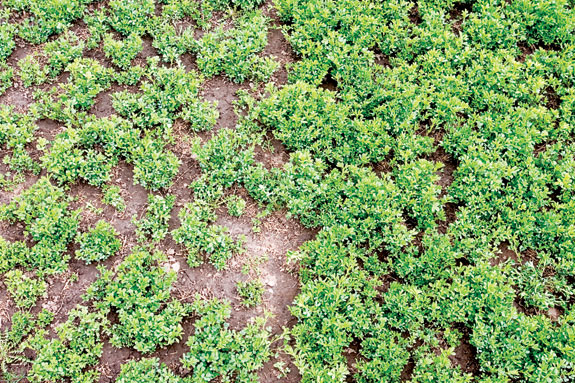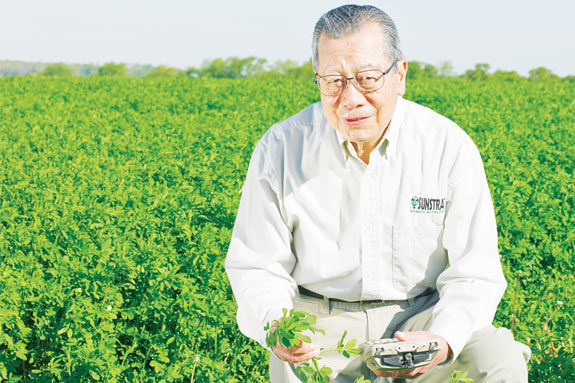As a result, top-quality alfalfa prices climbed to $240 a ton or more this past season, depending on where you live.
This bull market in forage is welcome news for alfalfa growers.
To make sure your fields produce peak profits, hybrid alfalfa varieties may offer greater production and quality to help you reap these financial rewards.
Hybrid benefits
Alfalfa may be the queen of the forages crops, but advancements in crop performance via conventional breeding methods have been anything but royal.
A 1997 analysis of alfalfa performance studies at Midwestern universities indicated there was no evidence to conclude alfalfa yields had changed since the late 1970s.
In fact, overall cumulative alfalfa genetic yield progress was pegged at only about 10 to 15 percent from the 1940s to the late 1990s.
These results are similar to corn yield increases, which languished at only two bushels per acre from 1860 to 1930, prior to the introduction of hybrid varieties.
Similarly, when hybrid alfalfa varieties featuring a 7.4 percent yield increase became available in 2001, they changed everything.

Hybrids are developed through controlled pollination that helps capture the maximum heterosis, or hybrid vigor, and eliminate inbreeding depression.
The process capitalizes on elite alfalfa lines, while preventing random pollination and inbreeding found in conventional alfalfa breeding programs.
This strategy increased genetic yield gain and led to the introduction of the first hybrid alfalfa, Dairyland Seed’s HybriForce-400.
Just as hybridization revolutionized corn production, this technology dramatically altered the genetic yield potential of alfalfa.
A second hybrid alfalfa generation – HybriForce-2400 Gen-2 – released in 2009 added even more opportunity for growers.
This generation increased the industry standard for annual genetic yield gain from 0.34 percent to 0.67 percent. These hybrids produce higher yields compared to other leading alfalfa varieties 85 percent of the time in university trials.
A third generation is currently in development. Researchers fully expect they will be able to deliver a full percentage point of annual genetic yield gain when this technology advancement is ready for release.
More yield
Meanwhile, thanks to alfalfa hybrids already available, you can produce the highest forage yield possible from every acre.
To put a few figures to that idea, assume that a four-year stand of alfalfa normally produces 20 tons of alfalfa per acre.
If you plant hybrid alfalfa with its 7.4 percent expected yield gain over conventional alfalfa, one bag of hybrid alfalfa can produce an additional 4.5 tons of alfalfa.
Even if the crop is valued at $150 per ton, you’ve just earned $675 more than if you had planted a conventional variety. Similarly, in tons per acre using an average yield range of 4 to 8 tons per acre per year, hybrid alfalfa would yield from one-third of a ton to two-thirds of a ton more per acre per year.
Producers are seeing these results around the country. For example, Kevin Brower, a commercial hay grower from Iowa, yielded 1.5 dry tons per acre more with second-generation hybrid alfalfa than conventional varieties planted in the same field this year.
Additional agronomic advantages
You can also anticipate greater consistency in yield and forage quality due to the uniformity of maturity and physical plant characteristics of hybrid alfalfa.
Whole fields are more apt to be ready at one time versus areas of fields maturing at different stages. Fine plant stems equate to faster drydown after cutting, denser bales and better palatability.
These hybrids also offer increased spring vigor, meaning you can usually cut fields earlier with less risk of stress or stand loss.
You’ll also note faster regrowth and more vigorous plants. That’s because photosynthesis begins sooner and plants begin taking up water and nutrients more quickly after a cutting.
Hybrid alfalfa holds up well under a variety of cutting strategies as well. The genetics have been tested in both 21-day through 35-day cutting schedules with excellent results.
The crop can handle aggressive cutting schedules and performs well when cutting is delayed, too.
Furthermore, these hybrids, especially those from the second generation, show excellent tolerance for a number of different soil types, field conditions and weather extremes.
Hybrid alfalfa lines are chosen for their persistence as well. So when other alfalfa stands show a drop in yield over time, hybrid alfalfa stands tend to decline less than their conventional counterparts.
In some cases under favorable conditions, the stand may actually increase its performance over prior-year yields.
All of these factors add up to a compelling case for hybrid alfalfa. If you haven’t considered this technology for your toolbox yet, give it a look. You’ll notice a difference in your fields and in your bottom line. FG
PHOTO:
Photo 1: The patented technology behind hybrid alfalfa – msSunstra® – is the result of 24 years of research by Dr. Paul Sun, Dairyland Seed’s special project scientist.
Photo 2: Hybrid alfalfa is characterized by highly uniform stands of dense, distinct, fine-stemmed forage for higher yield, better bales, less dry-down time and even premiums in certain markets compared to conventional alfalfa. Photos courtesy of Dairyland Seed.

Chad Staudinger
Forage Product Manage
Dairyland Seed Company










